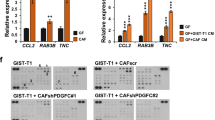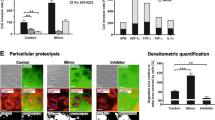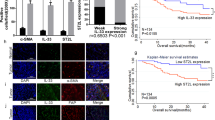Abstract
We reconstituted a three-dimensional gastric carcinoma model similar to invasive gastric carcinoma tissue. This model consists of a human gastric carcinoma cell line, GCTM-1, a human fibroblast cell line, TIG-1-20, and transforming growth factor-β (TGF-β)-containing type I collagen gel. Using this model, we were able to observe the growth of the two cell types, especially carcinoma cell invasive growth, in real time for more than 30 days. TGF-β and TIG-1-20 were essential for GCTM-1 invasive growth and proliferation, respectively. TGF-β induced the enhanced expression of matrix metalloproteinase 9 (MMP9) and urokinase-type plasminogen activator (uPA) in GCTM-1 at both the protein and enzymatic activity levels. The TGF-β-induced invasion of GCTM-1 was inhibited by MMP9- or uPA-antisense (AS) oligonucleotide transfection to GCTM-1. When exogenous interferon-γ (IFN-γ) was added to this model, TGF-β-dependent GCTM-1 invasion was significantly inhibited, concomitant with the decreased expression of MMP9 and uPA. The intracellular signal transduction of Smad was examined to analyse the mechanism of the inhibitory effect of IFN-γ. TGF-β accelerated the phosphorylation of Smad2/3 and nuclear translocation of the Smad2/3–Smad4 complex in GCTM-1, but these TGF-β-induced effects were significantly inhibited by IFN-γ-induced Smad7 expression. When GCTM-1 was cotransfected with AS oligonucleotide of Smad2 and Smad3, the TGF-β-induced invasion of GCTM-1 disappeared. In addition, the inhibitory effect of IFN-γ on TGF-β-dependent GCTM-1 invasion vanished by the AS oligonucleotide of Smad7 transfection. These results indicate that IFN-γ inhibits TGF-β-dependent GCTM-1 invasion through cross-talk in the Smad pathway. IFN-γ may be a new therapeutic tool for TGF-β-expressed invasive carcinomas.
This is a preview of subscription content, access via your institution
Access options
Subscribe to this journal
Receive 50 print issues and online access
$259.00 per year
only $5.18 per issue
Buy this article
- Purchase on Springer Link
- Instant access to full article PDF
Prices may be subject to local taxes which are calculated during checkout








Similar content being viewed by others
Abbreviations
- TGF:
-
transforming growth factor
- MMP:
-
matrix metalloproteinase
- uPA:
-
urokinase-type plasminogen activator
- IFN:
-
interferon
- b-FGF:
-
basic fibroblast growth factor
- AS:
-
antisense
- CBP:
-
cAMP response element-binding protein
- JAK:
-
janus kinase
- STAT:
-
signal transducer and activator of transcription
- FCS:
-
fetal calf serum
- FACS:
-
fluorescence-activated cell sorter
- SDS:
-
sodium dodecyl sulfate
- PAGE:
-
polyacrylamide gel electrophoresis
References
Albini A, Iwamoto Y, Kleinman HK, Martin GR, Aaronson SA, Kozlowski JM and McEwan RN . (1987). Cancer Res., 47, 3239–3245.
Alexandrow MG and Moses HL . (1995). Cancer Res., 55, 1452–1457.
Ankrapp DP and Bevan DR . (1993). Cancer Res., 53, 3399–3404.
Arnoletti JP, Albo D, Granick MS, Solomon MP, Castiglioni A, Rothman VL and Tuszynski GP . (1995). Cancer, 76, 998–1005.
Attisano L and Lee-Hoeflich ST . (2001). Genome Biol., 2, 3010.1–3010.8..
Bakin AV, Tomlinson AK, Bhowmick NA, Moses HL and Arteaga CL . (2000). J. Biol. Chem., 275, 36803–36810.
Bauman GS, Fisher BJ, Mcdonald W, Amberger VR, Moore E and Del Maestro RF . (1999). Int. J. Dev. Neurosci., 17, 643–651.
Bell HS, Wharton SB, Leaver HA and Whittle IR . (1999). J. Neurosurg., 91, 989–996.
Chen SJ, Yuan W, Lo S, Trojanowska M and Varga J . (2000). J. Cell. Physiol., 183, 381–392.
Chen SJ, Yuan W, Mori Y, Levenson A, Trojanowska M and Varga J . (1999). J. Invest. Dermatol., 112, 49–57.
Coffey Jr RJ, Sipes NJ, Bascom CC, Graves-Deal R, Pennington CY, Weissman BE and Moses HL . (1988). Cancer Res., 48, 1596–1602.
David M . (1995). Pharmacol. Ther., 65, 149–161.
Dong C, Li Z, Alvarez Jr R, Feng XH and Goldschmidt-Clermont PJ . (2000). Mol. Cell, 5, 27–34.
Ebisawa T, Fukuchi M, Murakami G, Chiba T, Tanaka K, Imamura T and Miyazono K . (2001). J. Biol. Chem., 276, 12477–12480.
Ellenrieder V, Hendler SF, Ruhland C, Boeck W, Adler G and Gress TM . (2001). Int. J. Cancer, 93, 204–211.
Ellis MJ, Singer C, Hornby A, Rasmussen A and Cullen KJ . (1994). Breast Cancer Res. Treat., 31, 249–261.
Festuccia C, Angelucci A, Gravina GL, Villanova I, Teti A, Albini A, Bologna N and Abini A . (2000). Int. J. Cancer, 85, 407–415.
Fink SP, Swinler SE, Lutterbaugh JD, Massague J, Thiagalingam S, Kinzler KW, Vpgelstein B, Willson JKV and Markowitz S . (2001). Cancer Res., 61, 256–260.
Funaba M, Zimmerman CM and Mathews LS . (2002). J. Biol. Chem., 277, 41361–41368.
Ghosh AK, Yuan W, Mori Y, Chen SJ and Varga J . (2001). J. Biol. Chem., 276, 11041–11048.
Giehl K, Seidel B, Gierschik P, Adler G and Menke A . (2000). Oncogene, 19, 4531–4541.
Gurujeyalakshmi G and Giri SN . (1995). Exp. Lung Res., 21, 791–808.
Hayashi H, Abdolla, S, Qiu Y, Cai J, Xu YY, Grinnell BW, Richardson MA, Topper JN, Gimbrone Jr MA, Wrana JL and Falb D . (1997). Cell, 89, 1165–1173.
Hlatky L, Tsionou C, Hahnfeldt P and Coleman CN . (1994). Cancer Res., 54, 6083–6086.
Hofland LJ, van der Burg B, van Eijck CH, Sprij DM, van Koetsveld PM and Lamberts SW . (1995). Int. J. Cancer, 60, 93–99.
Ignotz RA and Massague J . (1986). J. Biol. Chem., 261, 4337–4345.
Inagaki Y, Mamura M, Kanamaru Y, Greenwel P, Nemoto T, Takehara K, ten Dijke P and Nakao A . (2001). J. Cell Physiol., 187, 117–123.
Itoh S, Itoh F, Goumans MJ and ten Dijke P . (2000). Eur. J. Biochem., 267, 6954–6967.
Kavsak P, Rasmussen RK, Causing CG, Bonni S, Zhu H, Thomsen GH and Wrana JL . (2000). Mol. Cell, 6, 1365–1375.
Keski-Oja J, Blasi F, Leof EB and Moses HL . (1988). J. Cell Biol., 106, 451–459.
Kikuchi S, Sato T, Arai Y, Tsutsumi O, Hiki Y and Kakita A . (2000). Hepatogastroenterology, 47, 1256–1259.
Kunz-Schughart LA, Heyder P, Schroeder J and Knuechel R . (2001). Exp. Cell Res., 266, 74–86.
Leivonen SK, Chantry A, Hakkinen L, Han J and Kahari VM . (2002). J. Biol. Chem., 277, 46338–46346.
Liotta LA, Steeg PS and Stetler-Stevenson WG . (1991). Cell, 64, 327–336.
Lund LR, Ellis V, Ronne E, Pyke C and Dano K . (1995). Biochem. J., 310, 345–352.
Ma Z, Qin H and Benveniste EN . (2001). J. Immunol., 167, 5150–5159.
Mahara K, Kato J, Terui T, Takimoto R, Horimoto M, Murakami T, Mogi Y, Watanabe N, Kohgo Y and Niitsu Y . (1994). Br. J. Cancer, 69, 777–783.
Markowitz SD and Roberts AB . (1996). Cytokine Growth Factor Rev., 7, 93–102.
Matrisian LM, Cunha GR and Mohla S . (2001). Cancer Res., 61, 3844–3846.
Meier F, Nesbit M, Hsu MY, Martin B, van Belle P, Elder DE, Schaumburg-Lever G, Garbe C, Walz TM, Donatien P, Crombleholme TM and Herlyn M . (2000). Am. J. Pathol., 156, 193–200.
Montgomery E, Goggins M, Zhou S, Argani P, Wilentz RE, Kaushal M, Booker S, Romans K, Bhargava P, Hruban RH and Kern SE . (2001). Am. J. Pathol., 158, 537–542.
Mori Y, Chen SJ and Varga J . (2000). Exp. Cell Res., 258, 374–383.
Morisaki T, Matsunaga H, Beppu K, Ihara E, Hirano K, Kanaide H, Mori M and Katano M . (2000). Anticancer Res., 20, 3363–3373.
Morrissey D, O'Connell J, Lynch D, O'Sullivan GC, Shanahan F and Collins JK . (1999). Clin. Exp., Metastasis, 17, 77–85.
Moses HL, Yang EY and Pietenpol JA . (1990). Cell, 63, 245–247.
Nakamura M, Katano M, Kuwahara A, Fujimoto K, Miyazaki K, Morisaki T and Mori M . (1998). Br. J. Cancer, 78, 1373–1378.
Nakao A, Afrakhte M, Moren A, Nakayama T, Christian JL, Heuchel R, Itoh S, Kawabata M, Heldin NE, Heldin CH and ten Dijke P . (1997). Nature, 389, 631–635.
Overall CM, Wrana JL and Sodek J . (1989). J. Biol. Chem., 264, 1860–1869.
Pasche B . (2001). J. Cell Physiol., 186, 153–168.
Razandi M, Pedram A, Park ST and Levin FR . (2003). J. Biol. Chem., 278, 2701–2712.
Rossi L, Reverberi D, Podesta G, Lastraioli S and Corvo R . (2000). Int. J. Cancer, 85, 667–673.
Saito H, Tsujitani S, Oka S, Kondo A, Ikeguchi M, Maeta M and Kaibara N . (1999). Cancer, 86, 1455–1462.
Sandusky G, Berg DT, Richardson MA, Myers L and Grinnell BW . (2002). J. Biol. Chem., 277, 49815–49819.
Sehgal I, Baley PA and Thompson TC . (1996). Cancer Res., 56, 3359–3365.
Shipley GD, Pittelkow MR, Wille Jr JJ, Scott RE and Moses HL . (1986). Cancer Res., 46, 2068–2071.
Shyu RY, Su HL, Yu JC and Jiang SY . (2000). J. Surg. Oncol., 75, 122–130.
Sowa H, Kaji H, Yamaguchi T, Sugimoto T and Chihara K . (2002). J. Biol. Chem., 277, 36024–36031.
Teti A, De Giorgi A, Spinella MT, Migliaccio S, Canipari R, Onetti Muda A and Faraggiana T . (1997). Int. J. Cancer, 72, 1013–1020.
Torre-Amione G, Beauchamp RD, Koeppen H, Park BH, Schreiber H, Moses HL and Rowley DA . (1990). Proc. Natl. Acad. Sci. USA, 87, 1486–1490.
Tredget EE, Wang R, Shen Q, Scott PG and Ghahary A . (2000). J. Interferon Cytokine Res., 20, 143–151.
Ulloa L, Doody J and Massague J . (1999). Nature, 397, 710–713.
Ura H, Obara T, Yokota K, Shibata Y, Okamura K and Namiki M . (1991). Cancer Res., 51, 3550–3554.
Verrecchia F, Tacheau C, Wangner EF and Mauviel A . (2003). J. Biol. Chem., 278, 1585–1593.
Welch DR, Fabra A and Nakajima M . (1990). Proc. Natl. Acad. Sci. USA, 87, 7678–7682.
Yashiro M, Chung YS, Kubo T, Hato F and Sowa M . (1996). Br. J. Cancer, 74, 1096–1103.
Yu L, Herert MC and Zhang YE . (2002). EMBO J., 21, 3749–3759.
Acknowledgements
We thank Kaori Nomiyama for providing expert technical assistance. This work was supported by grants for General Scientific Research (12557106) from the Ministry of Education, Culture, Sports, Science, and Technology of Japan.
Author information
Authors and Affiliations
Corresponding author
Rights and permissions
About this article
Cite this article
Kuga, H., Morisaki, T., Nakamura, K. et al. Interferon-γ suppresses transforming growth factor-β-induced invasion of gastric carcinoma cells through cross-talk of Smad pathway in a three-dimensional culture model. Oncogene 22, 7838–7847 (2003). https://doi.org/10.1038/sj.onc.1207046
Received:
Revised:
Accepted:
Published:
Issue Date:
DOI: https://doi.org/10.1038/sj.onc.1207046
Keywords
This article is cited by
-
c-Kit signaling potentiates CAR T cell efficacy in solid tumors by CD28- and IL-2-independent co-stimulation
Nature Cancer (2023)
-
Regulation gene expression of miR200c and ZEB1 positively enhances effect of tumor vaccine B16F10/GPI-IL-21 on inhibition of melanoma growth and metastasis
Journal of Translational Medicine (2014)
-
Inclusive estimation of complex antigen presentation functions of monocyte-derived dendritic cells differentiated under normoxia and hypoxia conditions
Cancer Immunology, Immunotherapy (2012)
-
Nuclear factor kappaB-activated monocytes contribute to pancreatic cancer progression through the production of Shh
Cancer Immunology, Immunotherapy (2010)
-
IFN-γ down-regulates TGF-β1-induced IgA expression through Stat1 and p300 signaling
Molecules and Cells (2010)



